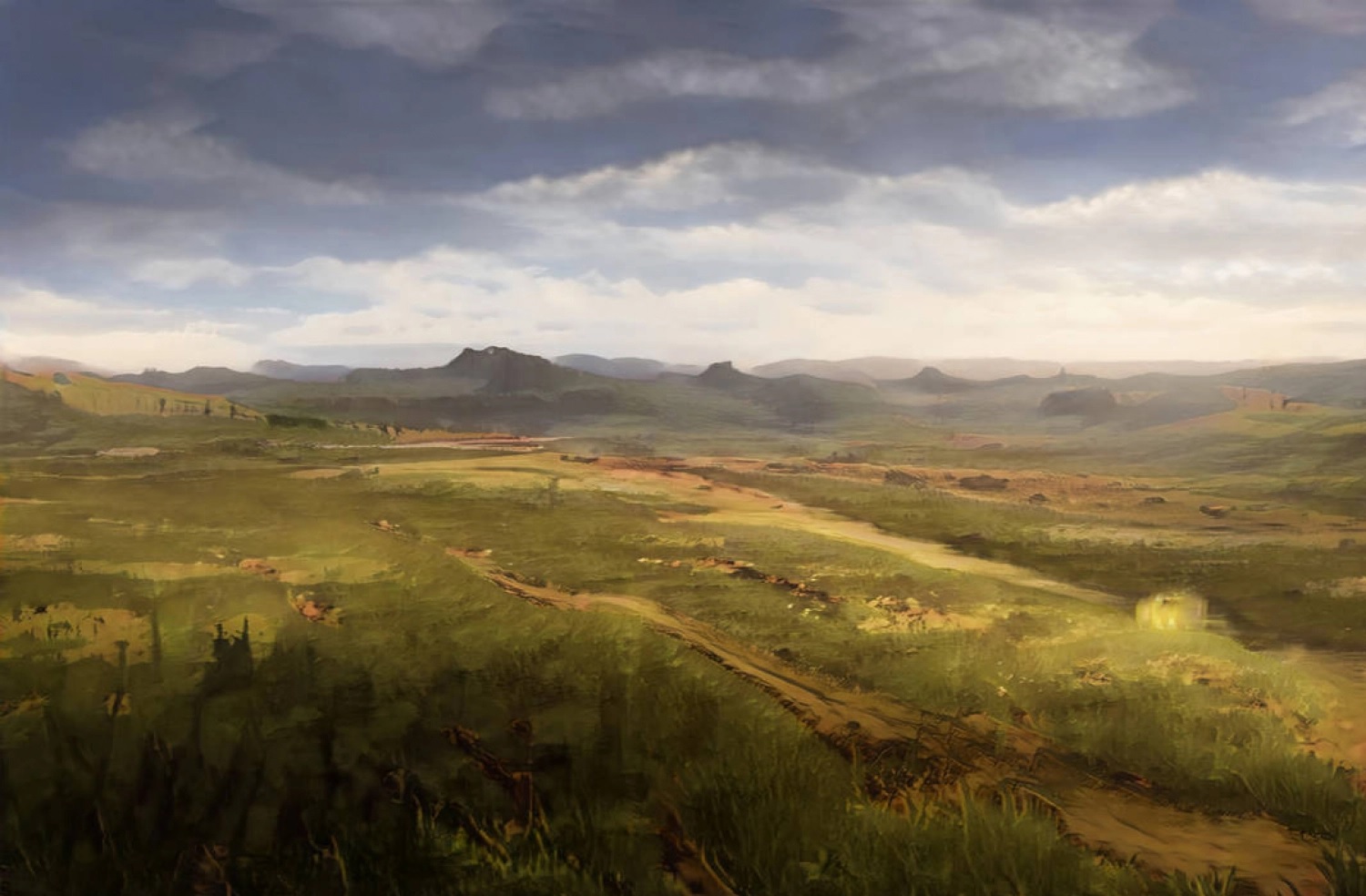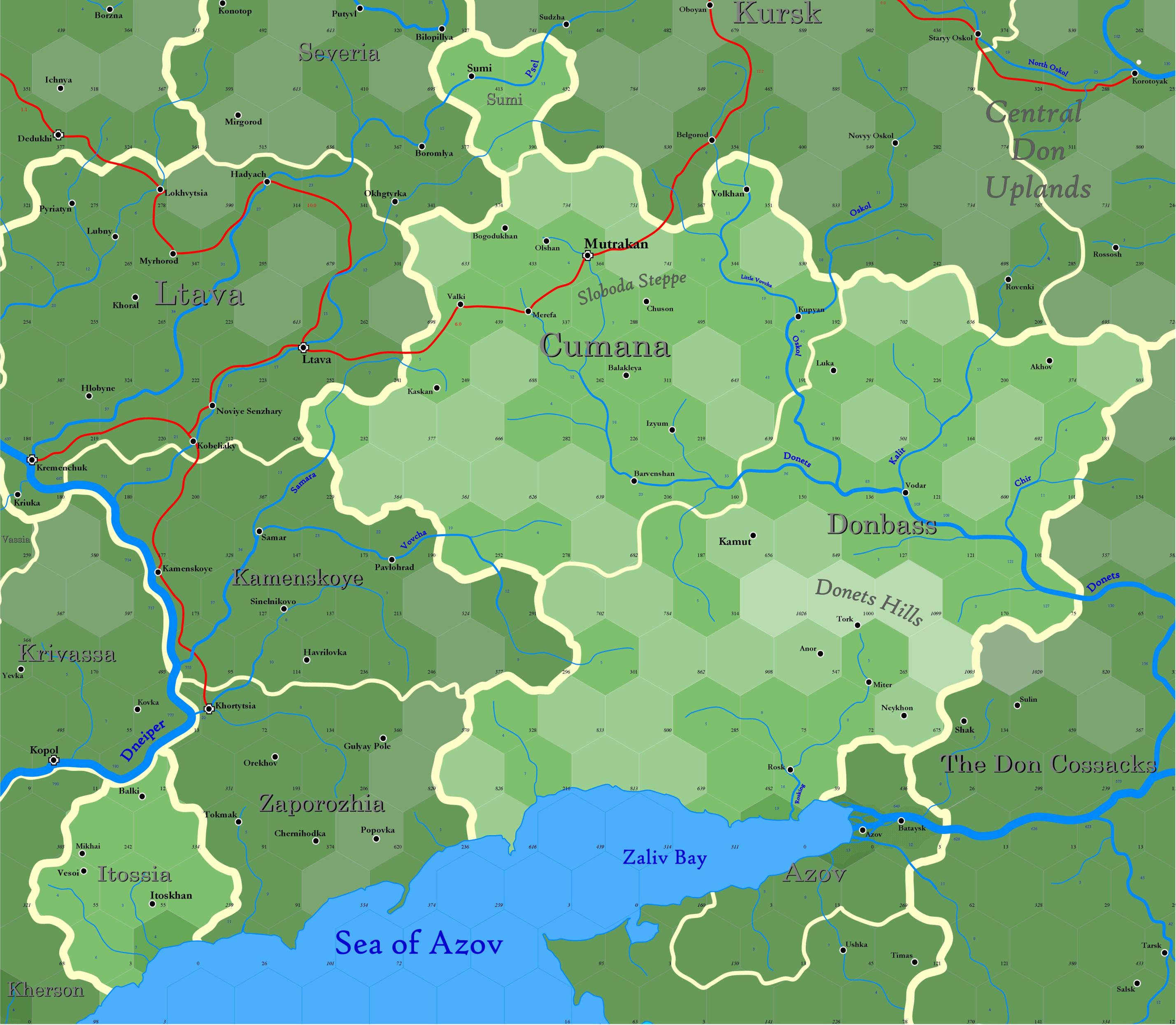Cumana
The Sanjak of Cumana is a half-orc sanjak in the Tatar Steppe between the Dneiper and Don rivers, north of the Black Sea. The region borders on Moskva, Kiyev, the Ottoman Empire, Zaporozhia and lands of The Don Cossacks. The sanjak covers an area of 98.5 hexes, with a population of 337,782. Mutrakan, the largest city, has a population of 85,218. Other important centers include Sumi (6,452), Itoskhan (5,832) and Kamut (4,330).
Contents
History
Arrival of the Cumans
During the 9th and 10th centuries, tribes of pure-blood orcs and half-bloods migrated from the steppes below the Altai mountains, emerging north of the Caspian Sea in the 11th century. The Pechenegs came first, followed by Cumans and Kipchaks. The latter groups raided the Khazars and parts of eastern Rus, before sweeping over the Don River into Kiyevan lands. In 1061, the Cuman chieftain Sokal led his people into the heart of Kiyev, invading and devastating the Dneiper Bank, beginning a seasonal war that would last for 175 years. Raiding continued year after year, until the Kiyevan forces established a protective front in 1107.
The pureblood Kipchaks and half-orc Cumans formed a loose confederation after 1080, ruling over the lower Dneiper eastward to the Volga. They fought wars with the Rus, the Seljuk Turks and Circassians. In 1086, a huge Cuman and Pecheneg force defeated Alexius Comnenus of Byzantium in 1086, ravaging the entire eastern Balkan region, up to the walls Constantinople itself. In 1091, after two years of siege, Alexius bought the Cumans off, turning them against the Pechenegs. By 1126, the Pecheneg hets (chieftains) were broken and many of the people massacred.
Cuman Suzerainty
As Kipchaks interbred with Cuman tribes, the resultant battle-lusting clans exercised their influence from the Black Sea to Novgorod. The sack of Kiyev in 1169 enabled them to raid further afield, into Bessarabia, Ruthenia and even Hungary. For 20 years, Moldavia became a Cuman military camp, enabling attacks into Bulgaria and Wallachia into the 1190s.
However, the Cuman hets grew less cohesive with the 13th century, with large numbers hiring as mercenaries. Kipchak tribes, blending with Dwarves of the Donets valley and humans, grew passive and agrarian, settling the lower Don and Volga valleys.
Mongols
The approach of the haruchai general Temujin following the capture of Bokhara (1219) and Samarkand (1220), a combined force of Cumans and Russians weree destroyed at the battle of the Kalka River in 1223. The Kipchak tribes were obliterated and enslaved, while Cuman populations were scattered, slaughtered or forced to submit as members of Tatar clans. These latter were organized as a slave-army of the Khanate of the Golden Horde under Batu Khan between 1237 and 1240, occupying the lands which are today Cumana.
As the Haruchai Tatars maintained their grip on the Crimean Peninsula, adopting Islam, the Cumans embraced the Russian stand on the Ugra River in 1480. Adopting Eastern Orthodoxy, Ivan the III bequeathed them lands south and west of the Don River; this is the first historical use of "Cumana" to describe a political entity.
Sanjak of Cumana
Cumana would remain a client state of Russia until 1491, while still remaining friendly with the latter. The conquest of the Tatar state by the Ottomans would create a hundred years of conflict between Cumana and the Turks, until a settlement was reached in 1610; since that time, a yearly tribute has been paid to the Ottomans. Existing as a buffer state, Cumana survives so long as its friends and enemies hesitate to provoke an all out war between north and south. Both Moskva and the Ottomans have other more dangerous enemies; the maintenance of peace with Cumana offers both a relatively safe border.
Divisions
Cumana Sanjak has four Hets, composed of seven tribes: the Bonyaki, Dwarka, Gurdut, Sharukan, Torkastra, Yetabeshi and Zolozi.
- Cumana forms the main body of the sanjak, dominated by the hilly Sloboda Steppe, surrounding the great walled city of Mutrakan. The upper Donets valley is highly agrarian. A trade road connects Mutrakan with Ltava to the west and Kursk to the north.
- Donbass is an important mining region dominated by the Dwarka, a half-orc and dwarven people. The Donets Hills are an imposing highland in the central Het; to the south, rolling country extends south to the Sea of Azov and the Ottoman border.
- Itossia exists as a separate enclave separated from main Cumana by the Zaporozhian kingdom; it's security against the Ottomans is guaranteed by treaty by the Zaporozhians, to whom it pays a light tribute.
- Sumi is a tiny enclave between Cumana and Moskva, famous for its school of magic; much of the scholarly class originates in the city of Sumi. The area's soil make it an important agrarian center.
Trade
Mutrakan is the only market center, setting all prices within the Sanjak; the city manufactures flour, snuff, refined sugar from beets, wool and hides. Timber from the wooded steppe along the Moskva border is sawn and used to make wagons. The surrounding region is a bread basket of cereals, with tobacco and vegetables grown in garden plots. Cattle and swine are important livestock. Sheep for wool and hides are raised in Itossia.
Thanks to the Donbass Dwarka, the sanjak is one of the most important mining parts of the world, producing phenomenal amounts of coal and rock salt; it's one of the world's major producers of mercury. The Donbass also smelts pig iron from significant iron ore that's also mined. The Dwarka engage in metallurgy, tool making and metalsmithing.
Apart from the main trade route through Mutrakan, there's considerable smuggling that brings in goods across the Sea of Azov and the Ottoman Empire. Itossia is another source of clandestine trade.
See Also,
Map D.04 - Don & Volga
Political Divisions of the World

